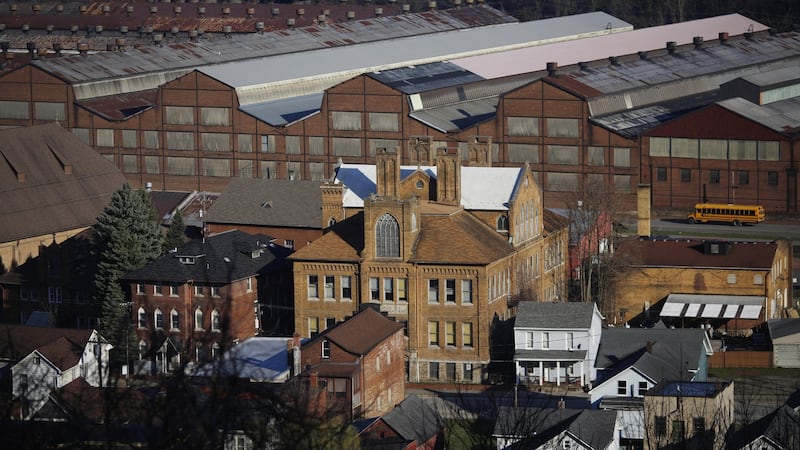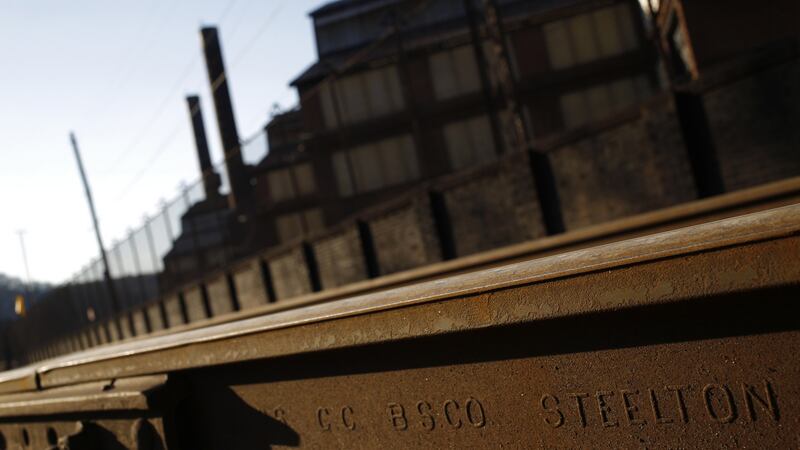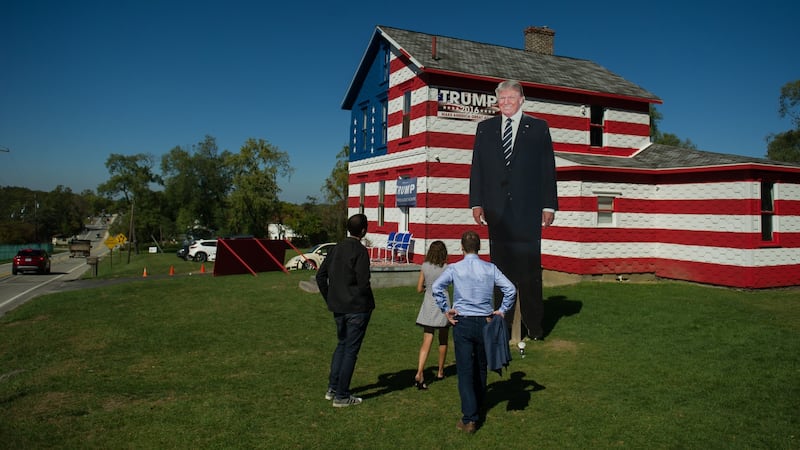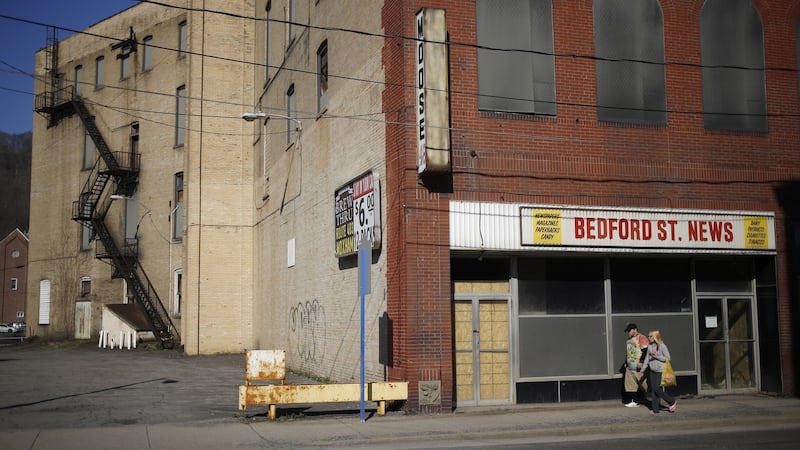As the sun moves slowly down the sky and the open road widens ahead, it’s as if life shifts down a gear. Driving west along the I-76, the long empty interstate that winds into the heart of rural Pennsylvania, the great eastern seaboard cities of New York, Philadelphia and Baltimore slip from memory.
Strains of country music alternate with the tones of Christian stations crackling from the radio. Outside, dusty front yards and abandoned buildings whizz by, depicting a picture of rural America that is rarely witnessed by the urban elites.
This is Trump country. It was states like Pennsylvania, Ohio and Michigan that helped the firebrand Republican shatter the electoral consensus and win the White House in November. A strong rural turnout helped tilt the so-called rust belt states towards the Republican candidate for the first time in decades. Those "forgotten men and women" Trump addressed in his inauguration speech on January 20th turned out in their tens of thousands for Trump on election day, propelling their man to the White House.
Amid the twists and turns of the Appalachian mountain range, the picturesque town of Johnstown gradually comes into view.
Nestled deep in a valley 60 miles east of Pittsburgh, Johnstown is a town proud of its history.
Settled in the 1770s, it rapidly became the most important town in the district thanks to its location on a key crossing point on the Pennsylvanian canal. The arrival of the railroads was a further boost, facilitating the development of the region’s huge mineral wealth and spawning a vibrant steel and coal industry.
But the headlong rush to economic success was not without its casualties. In 1889 tragedy struck, after heavy rain caused a dam to burst, unleashing 20 tons of water into the streets and claiming the lives of 2,200 people.
Today, a museum to the Great Flood on the edges of the town is one of the few attractions in a town that has long lost its lustre. It seems a poignant, tragic symbol of a place that has been swept away by the tides of economic change.
On this sunny Saturday afternoon in April, the streets of Johnstown are deathly quiet.
While the first stirrings of summer have brought out some afternoon walkers, the handsome central park is deserted. Along Main Street, many shops fronts are boarded up, buildings are for lease, the uncomfortable stillness is punctuated by the odd revving engine or the lonely sounds of the train that comes by just twice a day.
‘Yeah, I voted for him’
Sitting in a half-empty bar in downtown Johnstown, long-time resident Tony Sikorksi speaks quietly as he tells the story of his hometown. "There was a time when everyone here had a good job, a family, secure work. Now there's nothing, the mills have all closed. It's just old people. There's nothing here for younger people any more."
His comments are borne out by statistics.

Like many of the once former bustling towns that pepper the grand swathes of northeastern rural America, Johnstown suffered a catastrophic population decline in recent years. In 1925 the population stood at 75,000; today it has fallen to 20,000. The broader hinterland of Cambria County witnessed the third-largest population decrease in the United States last year, registering a 4 per cent drop in net migration in 2016.
The reason for the decline is clear – the demise of the steel and coal industry. In its heyday in the years following the second World War, Johnstown's steel mills employed 18,000 people, producing much of the material for America's railroads and infrastructure. But by the 1980s, the steel mills began shutting down, crippled by oversupply and unable to compete with competition from Europe, China and South American economies.
Today, the great hulk of the rusting steel plant watches over the town, a potent reminder of Johnstown’s past glory.
Like many of his friends and family, Tom Sikorski voted for Donald Trump in last year's presidential election. "Yeah, I voted for him. He's a businessman. If he can run a business he can run the United States of America. It's worth giving him a chance."
He's a businessman. If he can run a business he can run the United States of America.
But three months after his election, and amid signs that he may be abandoning the economic nationalism he campaigned on, does he really believe that Trump will be the saviour that brings back jobs to America? “It’s worth a try,” he sighs, as he sips a beer. “Everyone else has forgotten us.“
‘We’re going to deliver real change’
It was less than three weeks before the 2016 presidential election and Donald Trump strode on to a makeshift stage at the Cambria County War Memorial arena in Johnstown. The businessman and White House hopeful had just flown in from North Carolina, and was entering the final days of the campaign. Though perhaps more subdued than in previous rallies, the would-be president’s fiery words were to prove prescient.
“In 18 days we are going to win the state of Pennsylvania, and we are going to win back the White House. There’s something going on that’s very special. We’re leading nationwide. Together we’re going to deliver real change that once again puts America first,” he said to loud cheers from the crowd.
The would-be president would be proved right. Despite a RealClearPolitics poll in the days ahead of Trump's visit to Johnstown showing Hillary Clinton leading in Pennsylvania by more than six points, Trump became the first Republican since the 1980s to take the state.

As America’s fifth most populous state, representing 20 electoral college votes, Pennsylvania had long been seen by both Democrats and Republicans as a key swing state in the 2016 campaign.
Trump won the state by 0.7 percentage points, securing 48.6 per cent of the vote compared to Clinton's 47.9 per cent, reversing the 5.4 per cent percentage point win by Barack Obama in 2012.
Five months later, analysts are still piecing together the biggest electoral shock in modern American history.
What is clear is that Trump managed to harness the anger and deep sense of economic and cultural unease that has underpinned white, working-class America in recent years.
It's a cultural phenomenon captured in Hillbilly Elegy, the bestselling book by first-time novelist JD Vance, a memoir of white, working-class life in the Appalachian region of the rust-belt states. It's a book that has stayed in the New York Times bestseller list for 37 consecutive weeks as Americans try to make sense of their country. The book evokes the deep social and economic problems of a sector of American society that has been left behind by the forces of globalisation and economic change.
Almost a third of people in his grandparents' hometown of Jackson live in poverty and struggle with prescription drug addiction
As he recounts his personal journey from self-professed hillbilly to Yale law school graduate, Vance peppers his narrative with uncomfortable facts about 21st-century America: 20 per cent of those entering public high schools won’t make it to graduation; almost a third of people in his grandparents’ hometown of Jackson live in poverty and struggle with prescription drug addiction. It makes stark reading.
‘Hole in the economy’
This picture of American life is one that is recognised by Barry Denk. Born and raised in Johnstown, he is the director of the Centre for Rural Pennsylvania, an agency that promotes the cause of rural communities in the State. While he notes that some areas of Pennsylvania have seen an increase in population, with the state’s policy of pension taxation attracting retirees to the area, old manufacturing towns like Johnstown have suffered for years from net outward migration.
“What we have seen in cities like Johnstown is the disappearance of an economic lifeline, like the coal and steel industry. This left a major economic hole in the economy. Pennsylvania as a whole has a large ageing population. The state ranks among the highest in terms of the number of people who are born, are raised, and die in Pennsylvania.”

The state’s economic problems – where median incomes are well below the national average – have in turn generated serious social problems. Drug addiction tops the list.
“What we’re seeing is a public health crisis across the United States. Most of us were not prepared for this. It crept up on us, so for a while I think policymakers were on the defensive, but I think that tide is changing.”
The figures are startling. An estimated 35,000 people died in America last year due to opioid addiction. Though opioids include class-A drugs such as heroin, they also include strong, legal painkillers that can be obtained by prescription.
The problem is particularly acute in rural states with high unemployment like Pennsylvania and West Virginia.
“We’re losing 10 Pennsylvanians every day to opioid addiction,” says Denk, pointing out that the problem often begins with the over-prescription of regular, but highly addictive, painkillers.
“In the case of 80 per cent of heroin addicts, their addiction resulted from the abuse of prescription drugs. It’s not that they picked up a needle. There was a path that led to their addiction. They may have been prescribed a pain medication for a sports injury, or following a car accident. At some point in time they became addicted, with many moving on to heroin.”
It’s a problem that is familiar to the residents of Johnstown. As I walk around the quiet streets of Johnstown, a young couple point out the local library. Neat and pristine, it looks like an inviting place, but a man was carried out of here just over a year ago having overdosed in the bathroom.
Further down the street in the local police station, an on-duty police officer was found unconscious one Sunday afternoon having taken a drug designed to reverse overdoses.
The growing opioid crisis is attracting national attention. Trump cited the opioid epidemic frequently during his campaign – in his rally in Johnstown in 2016 he promised to stop the drug epidemic that is “poisoning our youth”.
Last month he appointed New Jersey governor Chris Christie to chair an opioid commission, which is due to examine new streams of federal funding to combat the crisis, but critics note that the Republican plan to repeal and replace Obamacare is likely to impact Medicaid recipients who use the state system to access treatment programmes.
‘Dead-end town, dead-end jobs’
Back in downtown Johnstown, a group of young men sit in front of the statue of the city's founder, Joseph Johns, in the central square.
“I’m just waiting to get out,” says Nathan, a 25-year-old local resident. His house in the Moxham area of the city was shot at twice in the last year, he says.
His uncle and father worked in the steel mills. He works part-time as a pizza delivery driver, and is hoping to move to Pittsburgh. “This is a dead-end town with dead-end jobs. Anyone who is not dumb here just leaves. There’s nothing for people who just want to work.”
While Nathan did not vote in the election, his friends and family all voted for Trump.

But three months into his presidency, there are signs that President Donald Trump is drifting away from the populist economic policies that resonated with the citizens of towns like Johnstown.
His promise to reignite the “rusted-out factories scattered like tombstones across the landscape of our nation” described so evocatively in his inauguration speech has yet to bear fruit.
His promise to deem China a currency manipulator and revisit the trade relationship between the US and China has been abandoned
His promise to deem China a currency manipulator and revisit the trade relationship between the US and China has been abandoned. His vow to bring back American coal jobs as he signed two executive orders last month ordering the relaxation of Obama-era environmental legislation was met by scepticism even by senior coal executives who quietly pointed out that most of the jobs in the energy sector have been lost to technology and automation, not to environmental legislation or foreign competition.
‘He stood up to the terrorists’
A Gallup poll this week shows that Trump’s popularity rating is languishing at 39 per cent, the lowest of any recent president at this point in his presidency. The percentage of Americans who think the president can bring about the change the country needs has also fallen by seven points from 53 per cent to 46 per cent.
But much of Trump’s low approval ratings reflect not a collapse in support from his core supporters but his failure to bring the other half of the country with him during what is typically a honeymoon period for new presidents. In Johnstown, most of the locals are nonplussed by Trump’s apparent U-turns.
Most are willing to give him the benefit of the doubt. “He is only in the job a few weeks. I think it’s good that he stood up to the terrorists last week dropping that bomb,” says Nathan’s friend, Mike. “Though I don’t want no war again in this country,” he trails off.
Nathan agrees. “He is willing to stand up for what he believes.”
The bomb that fell in Afghanistan, the air strikes on an airfield in Syria – Trump's forays into foreign wars seem a million miles away from rural Pennsylvania where life continues unaffected.
For many Johnstown residents, there is a sad stoicism about the future, a feeling that Trump, however disappointing he proves to be, is their last shot.
In many ways Johnstown could be any rural town in Ireland or Britain, left behind by a radically changed economic landscape which has seen western economies prioritise free trade and international commerce over economic nationalism.
No one here expects the jobs to come back. There is a pervading sense of being lost in the face of globalisation, that towns like Johnstown are literally dying.
As Trump ricochets from policy to policy, defying any coherent narrative, thoughts among Republicans are turning to next year’s midterm elections, as they wonder whether the Trump phenomenon will hold.
Electoral earthquake
But however the Trump presidency plays out, the electoral earthquake that Trump achieved in late 2016 has opened up broader questions for the Democratic party.
For much of the 20 century, voters like Nathan and his friends were exactly the kind of voters that Democrats could count on – blue-collar, hard-working, working class. The 2016 election saw that support evaporate, the culmination of a gradual shift in political alignment by blue-collar, white Americans in the rust-belt states from Democrat to Republican.
A new book published this week by two journalists, Jonathan Allen and Amie Parnes, is one of the first works to assess the failures of the Hillary Clinton campaign. The book, called Shattered, describes how the campaign ignored the "foreboding signs" that Clinton was failing to connect with swathes of the electorate months ahead of the election, how campaign officials ignored calls by democratic operatives on the ground for Clinton to campaign in rural areas and instead focused too much on getting out the vote among core supporters in urban centres.
It also describes how warnings by Bill Clinton – who had won the 1992 election on the mantra "it's the economy, stupid" – that the party was failing to present an economic message to white working-class voters were dismissed.
As America enters a prolonged period of introspection following the most divisive election in decades, the realisation that the Democrats stopped listening to the economic anxieties of a vast section of American society may ultimately be the biggest lesson that emerges from the Trump period.











